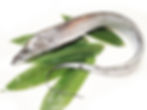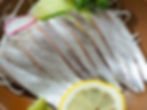
Fukuoka Fish Market
December 2025
KAN BURI - Wild Yellowtail
This is Kan-Buri from the Tsushima and Iki Islands in Nagasaki, Japan. These fish are not caught with nets but through the traditional method of single-hook fishing. This sustainable approach prevents overfishing and ensures each fish is carefully handled to maintain its freshness.
After being caught, the fish undergo “ikijime” and “shinkeijime,” traditional Japanese techniques that drain the blood and cut the nerves, preserving its exceptional quality and flavor.
Try our premium Kan-Buri and taste the difference.
KAN ISAKI - Japanese Grunt
It is generally said that this fish is best eaten in the rainy season of June. However, the fishermen know that the best ISAKI can be eaten in the winter as KAN-ISAKI prepares for the harsh cold weather by gaining more fat, resulting in a delicious, fatty taste. It is best eaten fresh as sushi or sashimi.

Mackerel

Sushi

Sashimi

Mackerel
INA SABA - Ina Mackerel (Wild)
Ina-Saba is a brand of Japanese mackerel that is caught in the rich sea of the Tsushima area. Only selected pieces are picked for Ina-Saba brand, according to the following strict standards:
1) Caught by pole-and-line
2) No scratches on the body
3) More than 6 hours cooling time immediately after harvest
4) Size

Beltfish

Beltfish

Sashimi

Beltfish
TACHIUO - Beltfish
The breeding season of tachiuo is June to October. In fall to winter, after the breeding season, the fish grows larger and the fatty taste is better.

Marbled Rockfish

Marbled Rockfish

Sushi

Marbled Rockfish
KASAGO - Marbled Rockfish
In Japan, the haiku seasonal word (kigo), of kasago is spring. However, in the present day, it is available year-round in the fish market. The taste is best from the end of November to February. In Fukuoka, it’s called arakabu and is a very popular fish in this area. It has refined white flesh and is quite perishable. However, we ship it very fresh to the U.S. market, maintaining its good quality.

Japanese Tilefish

Japanese Tilefish

Sushi

Japanese Tilefish
AMADAI - Japanese Tilefish
During the season from fall to early spring, amadai are especially rich in fat and have a naturally sweet, delicate flavor.

Black Skipjack

Sushi

Sashimi

Black Skipjack
SUMA - Black Skipjack
In western Japan, this fish is enjoyed as sashimi, grilled with salt, simmered, or fried. It is flavorful year-round but is particularly delicious from fall to spring.

Halfbeak

Halfbeak

Sushi

Halfbeak
SAYORI - Halfbeak
Sayori season is typically from winter to spring, but its flavor in autumn is also exceptional. It’s excellent for both hosozukuri and itozukuri preparations and is a must-have for hikarimono sushi.

Longtooth Grouper

Longtooth Grouper

Nabe

Longtooth Grouper
KUE - Longtooth Grouper
This prized fish is highly sought after in Japan due to its limited availability in the seafood market. While it’s delicious year-round, it’s especially well-suited for nabe (Japanese hot pot) during the cold winter months.

Blue Nose

Blue Nose

Grilled

Blue Nose
MEDAI - Bluenose
Medai is at its best from fall to winter and is appreciated for its ease of preparation, with small scales and easily cut bones. This fish offers excellent value, featuring white flesh with a rich umami flavor at a more reasonable price compared to other premium options. Its soft texture makes it versatile for various cooking styles, especially for simmered dishes and hot pot during the cold winter months.

Fluke

Sushi

Sashimi

Fluke
HIRAME - Fluke (Wild)
From November to February, during the cold winter season, this fish develops a firm texture and becomes rich with flavorful fat. While farm-raised hirame has become widely available in recent years, the taste of wild hirame during this peak season remains unparalleled.

Red Seabream

Sashimi

Dish

Red Seabream
MADAI - Red Seabream
This fish holds a special place in Japanese culture, often served during celebrations for generations. Its rich, flavorful fat beneath the skin makes it ideal for “Shimokawa-tsukuri” sashimi, which highlights this delicious layer. Grilling with the skin on further enhances its taste. While farm-raised sea bream has grown in popularity, wild-caught sea bream remains a prized choice in Japan’s seafood market.


Black Throat

Sashimi

AKAMUTSU - Black Throat
"Benihitomi" is a brand of akamutsu (red snapper) caught in the seas around Tsushima and Iki Islands using the traditional "Jigokunawa" fishing method. Known as the "King of Akamutsu," "Benihitomi" is celebrated for its exceptional quality.
MEJINA - Largescale Blackfish
If you're looking for the best MEJINA, now is the perfect season! Winter MEJINA boasts a fresh taste and rich, delicious fat. Its firm texture is often considered even superior to MADAI (sea bream). We recommend serving MEJINA with the skin on, prepared using the traditional "matsukawa zukuri" technique for an enhanced flavor experience.

Spear Squid

Spear Squid

Sushi

Spear Squid
YARI IKA - Spear Squid
Large quantities of this squid are caught during its breeding season from winter to spring, which is also the peak season for the best flavor. In Japan, if you're a fan of squid, kensaki-ika is great for summer, yari-ika is ideal for winter, and kiomochi-yari-ika (squid with eggs) is especially popular from winter to spring.
AORI IKA - Bigfin Reef Squid
Aoriika, often referred to as the king of squids, is renowned for its exceptional sashimi, considered the finest among all squid varieties. Its flesh is sweet and tender, yet firm in texture, making it a popular choice for Edomae-style sushi and tempura. This squid is a prized ingredient, beloved for its delicate balance of sweetness and texture..
